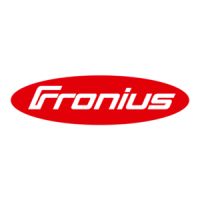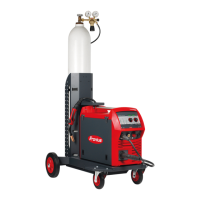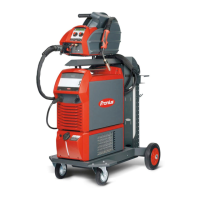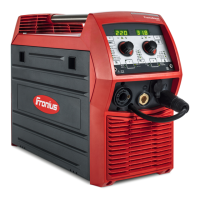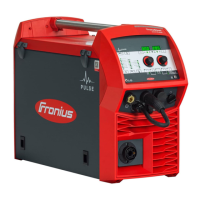
Do you have a question about the Fronius TransSteel 3000c Pulse and is the answer not in the manual?
| Brand | Fronius |
|---|---|
| Model | TransSteel 3000c Pulse |
| Category | Welding System |
| Language | English |
Explains safety symbols, general rules, intended use, and personnel/company obligations.
Covers environmental conditions, company/personnel obligations, and grid connection requirements.
Details personal protective equipment and dangers from toxic gases and vapors during welding.
Covers risks from flying sparks, fire, and electrical hazards from grid and welding currents.
Explains risks associated with stray welding currents and how to prevent them.
Discusses EMC classifications and measures to avoid electromagnetic interference.
Addresses EMF effects and identifies particular hazard areas like moving parts and hot components.
Covers shielding gas quality requirements and safety precautions for gas cylinders.
Details risks of gas leaks, safety during setup, transport, and normal operation.
Outlines procedures for maintenance, safety inspections, and proper disposal of the device.
Explains safety symbols, user responsibility for data backup, and copyright information.
Describes device concept, operating principle, application areas, and warning notices.
Details the arrangement and functions of buttons, dials, and the display on the control panel.
Identifies and describes front/back connections, switches, and mechanical components.
Describes the wirespool holder and the wire drive system.
Lists essential equipment required for different welding processes.
Covers safety precautions, intended use, and setup regulations for the device.
Details requirements for grid connection, including voltage and fuse protection.
Provides instructions for connecting the mains cable, including cable specifications and strain relief.
Details the process for fitting the strain relief device for mains cables.
Explains generator compatibility and selection criteria for power sources.
Covers commissioning, safety, and information on system components like trolleys and torches.
Details the process of assembling system components and establishing a ground earth connection.
Guides on safely inserting and changing feed rollers for the wire drive.
Provides instructions for safely inserting the wirespool into the holder.
Details the process for installing basket-type spools and safety precautions.
Guides on feeding the wire electrode into the drive system safely.
Provides details on wire feeding using the torch trigger or wire threading button.
Explains how to set the correct contact pressure for proper wire feeding.
Covers adjusting the wire spool brake and its design for proper unreeling.
Guides on setting the device's date and time upon first startup.
Explains the power limitation safety feature for MIG/MAG welding and how it functions.
Introduces operating modes and explains symbols for gas pre-flow, starting current, and welding current phases.
Describes the suitability and operation of 2-step and 4-step welding modes for tacking and long seams.
Details special 2-step and 4-step modes, including activation and parameter settings for enhanced welding.
Explains spot welding for overlapped sheets and 2-step stitch welding for thin sheets.
Describes 4-step stitch welding for longer seams on thin sheets, preventing material melt-through.
Safety warnings and preparation steps for MIG/MAG welding.
Lists the sections covered within MIG/MAG welding, including synergic, manual, and stitch welding.
Details setting up and executing synergic MIG/MAG welding processes using material, wire, and gas selection.
Covers parameters and operation for manual MIG/MAG welding without synergic function.
Describes procedures for spot and stitch MIG/MAG welding techniques.
Explains how to save, retrieve, and delete EasyJob operating points for welding processes.
Describes how to use the Up/Down welding torch to select saved EasyJob operating points.
Safety precautions and preparation steps for TIG welding operations.
Details the steps for performing TIG welding, including arc ignition and termination.
Explains pulsed TIG welding applications, principles, and current progression.
Provides steps to activate pulse welding by setting the pulse frequency parameter.
Safety guidelines and preparation steps for Manual Metal Arc (MMA) welding.
Covers MMA welding process, current adjustments, and initiation.
Describes the benefits and functions of HotStart and Anti-Stick for MMA welding.
Explains the functionality of Easy Documentation for saving welding data and lists documented parameters.
Details CSV file generation, PDF reports, and Fronius signature for data authenticity.
Provides steps to activate, deactivate, and set date/time for the documentation feature.
Explains the procedure for safely deactivating Easy Documentation to prevent data loss.
Guides on accessing, adjusting, and exiting the setup menu for various welding processes.
Lists and explains setup parameters for MIG/MAG synergic welding.
Details setup parameters specific to MIG/MAG standard manual welding.
Covers setup parameters for MMA and TIG welding processes.
Explains restrictions and navigation for the second level of the setup menu.
Provides specific parameter settings for MIG/MAG synergic welding in the 2nd level menu.
Details setup parameters for MIG/MAG standard manual welding in the 2nd level menu.
Covers setup parameters for MMA and TIG welding in the 2nd level menu.
Explains the importance of measuring welding circuit resistance and the procedure for MIG/MAG welding.
Details the steps for measuring welding circuit resistance in MMA welding.
Explains how to display welding circuit inductivity and the importance of correct hosepack arrangement.
Covers general troubleshooting, safety, and handling of displayed service codes (error messages).
Lists common error codes and their causes/remedies for troubleshooting.
Emphasizes safety precautions and outlines routine maintenance tasks for start-up and regular intervals.
Details periodic maintenance tasks for 2 and 6 months and specifies disposal guidelines.
Provides average consumption values for wire electrode and shielding gas during welding.
Summarizes technical specifications, including raw materials, voltage, and duty cycle explanation.
Lists detailed technical specifications for the power source, including electrical and physical properties.
Provides technical details on wire speed, drive, diameter, and noise emission.
Explains the welding program label on the device and the database structure.
Lists standard welding programs with material, gas, configuration, and diameter details for EU.
Details additional welding programs, including FCW and specific material types.
Lists standard welding programs with material, gas, configuration, and diameter details for US.
Details additional welding programs for US, including FCW and specific material types.

